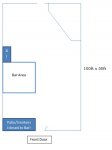Looking for opinions on coverage for a decent size club (5000 sq ft, 100x50 main area...see attached rough diagram. The ceiling is prob 15-18ft.). I've played in and been FOH in this room many times and while I've generally been happy with the results, I'm always looking for improvements. We'll be providing for a B/C level national this weekend and while we've made our standard 2 stacks per side (EV traps and MTL1's) work in the past, the corner stage and 100ft throw down the non-bar side is always a challenge, and the folks down there still pay good money to see the touring acts. I'll be taking center and possibly out-fill along this weekend to see about "helping" that side of the room. A delay stack won't really work without creating a big trip hazard, so there may not be much to be done, but I'll have some time to try a few things so i thought get some opinions.
This particular club is also looking at eventually doing an installed system and I'd be curious opinions there might be on addressing that same side. Covering the immediate area in front of the stage and up to the bar is pretty simple, but the long throw side is tough, ideally without killing the bartenders.
Thanks in advance
This particular club is also looking at eventually doing an installed system and I'd be curious opinions there might be on addressing that same side. Covering the immediate area in front of the stage and up to the bar is pretty simple, but the long throw side is tough, ideally without killing the bartenders.
Thanks in advance


